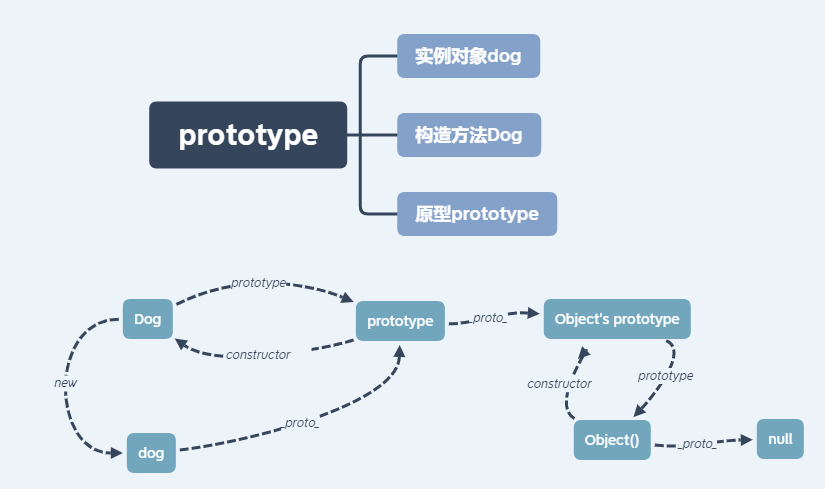Prototype
含义:proto(/ˈproʊtə/)原始, 原型, 原始的
目的:补充JavaScript对于对象的支持,通过protype来实现class中的method
过程:熟悉实例对象<—>构造函数<—>原型 三者之间的关系
1
2
3
4
5
6
7
|
function Dog() {
}
var dog = new Dog();
dog.name = '柯基';
console.log(dog.name)
|
- 构造函数通过prototype访问原型(一个类的属性,对象都可以访问)
- 实例对象通过
_proto_ 访问原型 === 构造函数通过prototype访问原型(原型也有_proto_)
- 实例原型通过
constructor访问构造函数(Dog=== Dog.prototype.constructor)

- 原型遵循向上原则,即找不到就不断向上(prototype)查询
- 原型因为不停延长形成链,称作原型链,但是
Object.prototype.__proto__ 的值为 null 跟 Object.prototype 没有原型
- 原型链大概实现了类(Class)以及继承(Extend)的问题,但它并不是复制,是建立一种关联,通过
prototype/_proto_ 来访问其他对象的属性和方法,属于委托/借用
Extend
一共分为6种
- 原型链继承
- 借用构造函数(经典继承)
- 组合继承
- 原型式继承
- 寄生式继承
- 寄生组合式继承
原型链继承
1
2
3
4
5
6
7
8
9
10
11
12
13
14
15
| function Parent () {
this.names = ['kevin', 'daisy'];
}
function Child () {}
Child.prototype = new Parent();
var child1 = new Child();
child1.names.push('yayu');
console.log(child1.names);
var child2 = new Child();
console.log(child2.names);
|
问题:
- 属性被所有child共享
- 创建child实例时,不能向parent传参
借用构造函数
1
2
3
4
5
6
7
8
9
10
11
12
13
14
15
| function Parent (name) {
this.name = name;
}
function Child (name) {
Parent.call(this, name);
}
var child1 = new Child('kevin');
console.log(child1.name);
var child2 = new Child('daisy');
console.log(child2.name);
|
有点:
- 避免引用类型的属性被所有实例共享
- 可以在Child中间parent传参
缺点:
- 方法在构造函数中定义,每次创建势力都会创建一遍方法
组合继承
以上两种方法的组合,为最常用的继承方式
1
2
3
4
5
6
7
8
9
10
11
12
13
14
15
16
17
18
19
20
21
22
23
24
25
26
27
28
29
| function Parent (name) {
this.name = name;
this.colors = ['red', 'blue', 'green'];
}
Parent.prototype.getName = function () {
console.log(this.name)
}
function Child (name, age) {
Parent.call(this, name);
this.age = age;
}
Child.prototype = new Parent();
Child.prototype.constructor = Child;
var child1 = new Child('kevin', '18');
child1.colors.push('black');
console.log(child1.name);
console.log(child1.age);
console.log(child1.colors);
var child2 = new Child('daisy', '20');
console.log(child2.name);
console.log(child2.age);
console.log(child2.colors);
|
